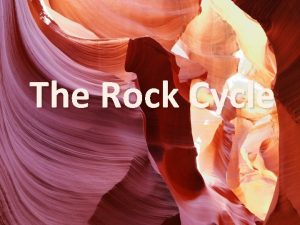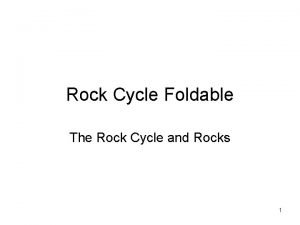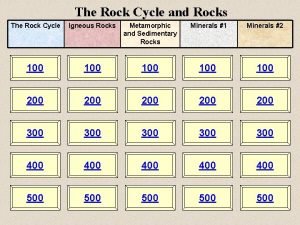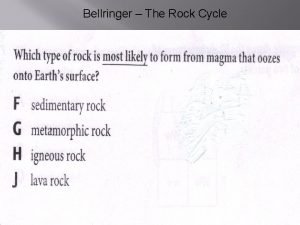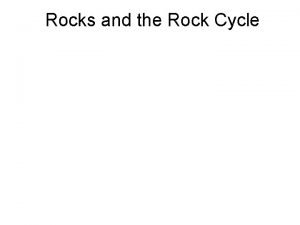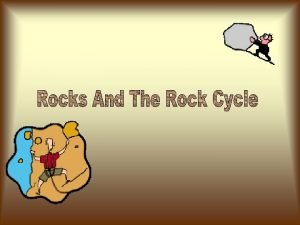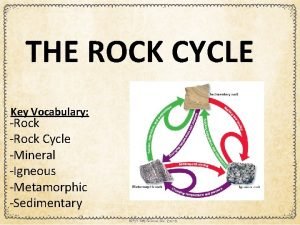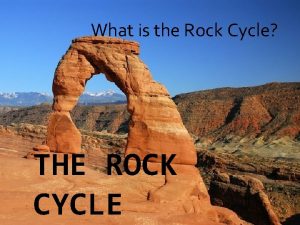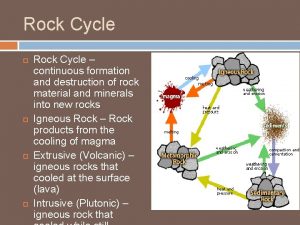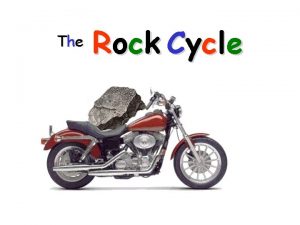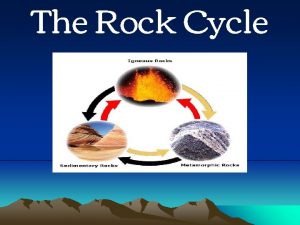What is the Rock Cycle THE ROCK CYCLE











































- Slides: 43

What is the Rock Cycle? THE ROCK CYCLE

The Rock Cycle Defined: The process by which all rocks on Earth are formed and how basic Earth materials are recycled over time Note: A very, very long time

The Rock Cycle Igneous Rock Sedimentary Rock Metamorphic Rock

Three main types of rock on Earth Igneous Rock: Forms from molten rock that cools and hardens either above or below Earth surface Two Types: Intrusive/Extrusive Sedimentary Rock: formed either by pieces of rock being bound together or by chemical precipitation Two types: Clastic/Non clastic Metamorphic Rock: Form when any type of rock is altered by the effects of heat, pressure, or chemical action Two Types: Foliated/ unfoliated

Watch the Video and fill in this Chart! http: //www. youtube. com/watch? v=U 7 YQ 5 vwa. L 98

Why does the Rock Cycle even exist? DENSITY (again) When rock is heated up and melted inside the Earth, it becomes hot liquid (magma) hot liquids are less dense then solid rock. The magma moves up through any cracks or openings (volcanoes, fissures) until it reaches the surfaces. Then spreads out, cools, and turns solid.

Why does the Rock Cycle even exist? Cont’d After rock is formed, one of two things will occur. 1. Rock will begin to erode into small sediments and settle somewhere else on Earth’s surface (sedimentary) 2. That rock will cool, turn solid, and become more dense, where over a long time period, will begin to sink. Thus causing a cycle!

Next time we will introduce Igneous Rocks, their formation, and types

IGNEOUS ROCKS Igneous Rock: Forms from molten rock that cools and hardens either above or below Earth surface. Igneous rocks are often defined by texture and chemical composition.

Igneous Rocks Identification of igneous rocks factors Texture: The feel, appearance, or consistency of a surface or a substance. (Simply what the rock type looks and feels like) mineral and chemical composition: What minerals does the rock consist of?

Igneous Rocks are made from volcanic activity and form when magma or lava cools Magma: Hot molten material INSIDE of the Earth’s surface Lava: Hot molten material OUTSIDE of the Earth’s surface MAJOR ELEMENTS PRESENT IN MAGMA Oxygen, Aluminum, Iron, Magnesium, Calcium, Potassium, and Sodium.

Igneous Rocks by Physical and Chemical Characteristics Intrusive Igneous Rocks: Course-grained igneous rock that cools slowly beneath the Earth’s surface. Extrusive Igneous Rocks Fine-grained igneous rocks that cool quickly on Earths surface overnight

Intrusive Igneous Rock Cools and turns solid very, very slowly below the Earths surface. Typically have large crystals present in the rock due to the slow cooling process .

Intrusive Igneous Rocks Granite is a coarse-grained, light colored, intrusive igneous rock that contains mainly quartz and feldspar minerals. The specimen above is about two inches (five centimeters) across. Diorite is a coarse-grained, intrusive igneous rock that contains a mixture of feldspar, pyroxene, hornblende and sometimes quartz. The specimen shown above is about two inches (five centimeters) across.

Extrusive Igneous Rocks Fined grained (smooth) rock that cools quickly on Earth's surface. Cools quickly due to exposure to the atmosphere, interaction with water, etc.

Extrusive Igneous Rocks Basalt is a fine-grained, dark-colored extrusive igneous rock composed mainly of plagioclase and pyroxene. The specimen shown is about two inches (five centimeters) across. Hawaiian Islands Obsidian is a dark-colored volcanic glass that forms from the very rapid cooling of molten rock material. It cools so rapidly that crystals do not form. The specimen shown above is about two inches (five centimeters) across.

Identifying Igneous Rock by Color FELSIC and MAFIC Igneous Rock Felsic: Light-colored Igneous Rocks. They are light in color due the minerals Feldspar and Silica being present in the mineral Mafic: Igneous Rocks that are dark in color due to the presence of Magnesium and Iron

Overview of Identification of Igneous Rocks IDENTIFICATION DEFINITION EXAMPLES Intrusive Cools and turns solid very, very slowly below the Earths surface. Typically have large crystals present in the rock due to the slow cooling process. Granite Diorite Extrusive Fined grained (smooth) rock that cools quickly on Earth's surface Basalt Obsidian Mafic Igneous Rocks that are dark in color due Obsidian to the presence of Magnesium and Iron Basalt Felsic Light-colored Igneous Rocks. They are light in color due the minerals Feldspar and Silica being present in the mineral Granite Diorite

Regents Scheme for Identifying Igneous Rocks

Sedimentary Rocks 2 nd most Abundant type of rock in the Earth system.

Sedimentary Rocks Defined: Rocks formed either by rock fragments or organic matter being bound together or by chemical precipitation.

Formation of Sedimentary Rock Very cool process Sedimentary rocks formed over millions of years. The form through a variety of processes beginning with Weathering and Erosion Step one. Weathering: General process where rocks are broken down at Earths surface to produce sediment particles Erosion: The process of individual sediments being carried down hill.

Two Types of Weathering Physical and Chemical Physical: occurs when solid rock is broken into smaller pieces by mechanical process that does not change the chemicals in the rock Chemical: Occurs when the minerals in a rock are chemical altered or disolved

Examples of physical weathering

Examples of Chemical Weathering

Formation of Sedimentary Rock Weathering occurs when either rain, Ice, wind, or water, breaks down solid rock over time into small, individual sediments Erosion: Sediments are carried from high energy to low energy areas. Typically occurs by water transporting the sediment down hill. Also by wind.

Transportation and Deposition Step two: Transportation: currents of wind and water or the moving ice of glaciers transport sediment to new locations down hill or down stream. Deposition: Occurs when sediment particles settle out as wind dies down, water currents slow, or glacier edges melt.


Step 3: Compaction and Cementation Compaction: Process of sediments building up in layers on top of each other over time Cementation: hardening of clastic sediments by the precipitation of mineral matter in the pore spaces. It is the last stage in the formation of a sedimentary rock.


Two Main Types of sedimentary Rock Clastic or Non-Clastic Sedimentary Rock-Made of small pieces of other types of rocks (igneous, metamorphic, sedimentary). And are cemented together after deposition. Non-clastic sedimentary rock: Non-clastic sedimentary rocks form from the precipitation (Precipitation is the separating of a solid from a solution) of minerals from ocean water or from the breakdown of the shells and bones of sea creatures.

Examples of Clastic Sedimentary Rock Sandstone: a clastic sedimentary rock made up mainly of sand-size weathering debris Conglomerate: a clastic sedimentary rock that contains large rounded clasts. generally filled with smaller particles and/or a chemical cement that binds the rock together. Shale: a fine-grained sedimentary rock that forms from the compaction of silt and clay-size mineral particles that we commonly call "mud".

Examples of Non- Clastic Limestone is a sedimentary rock composed primarily of calcium carbonate (Ca. CO 3) in the form of the mineral calcite. It most commonly forms in clear, warm, shallow marine waters. It is usually an organic sedimentary rock that forms from the accumulation of shell, coral, algal and fecal debris. It can also be a chemical sedimentary rock formed by the precipitation of calcium carbonate from lake or ocean water. Rock Salt is a chemical sedimentary rock that forms from the evaporation of ocean or saline lake waters. It is also known by the mineral name "halite". It is rarely found at Earth's surface, except in areas of very arid climate. It is often mined for use in the chemical industry or for use as a winter highway treatment.

ESRT Scheme for Identifying Sedimentary Rocks

Last but Not Least, Metamorphic Rock Defined: form when any rock is changed by the effects of heat, pressure, or chemical action. Two types of Metamorphism Regional or Contact Metamorphic rocks are typically characterized as: unfoliated or foliated.

Metamorphic Rock Metamorphic rocks form from either Igneous or Sedimentary rocks that are effected by pressure and heat within the Earths surface.

Metamorphic Rock New types of Metamorphic rock are formed depending on the amount of heat and pressure present around the rock. Example: Sedimentary Rock – Shale

Regional Metamorphism

Contact Metamorphism When molten rock come into contact with local rocks in a small area

Foliated Metamorphic Rocks Foliated Metamorphic Rock Definition: Metamorphic rocks whose minerals are squeezed together under high pressure and arranged in wavy layers or bands Examples: Gneiss is foliated metamorphic rock that has a banded appearance and is made up of granular mineral grains. It typically contains abundant quartz or feldspar minerals. Schist is metamorphic rock with well developed foliation. It often contains significant amounts of mica which allow the rock to split into thin pieces

Joke of the day…. If it looks nice, it is probably Gneiss… If it looks like Schist, it is probably Schist…. Get it? ? ? One more Example…. Slate is a fine-grained, foliated metamorphic rock that is created by the alteration of shale or mudstone by low-grade regional metamorphism

Nonfoliated Metamorphic Rocks Definition: Metamorphic rock that lacks mineral grains that are banded. Marble is a non-foliated metamorphic rock that is produced from the metamorphism of limestone Examples Quartzite is a non-foliated metamorphic rock that is produced by the metamorphism of sandstone.

 Sedimentary rocks turn into metamorphic
Sedimentary rocks turn into metamorphic Rock cycle sedimentary
Rock cycle sedimentary Igneous rocks metamorphic rocks and sedimentary rocks
Igneous rocks metamorphic rocks and sedimentary rocks Rock climb
Rock climb Chapter 3 standardized test practice answers
Chapter 3 standardized test practice answers A rock climber's shoe loosens a rock and her climbing buddy
A rock climber's shoe loosens a rock and her climbing buddy Illustrate the rock cycle
Illustrate the rock cycle Hình ảnh bộ gõ cơ thể búng tay
Hình ảnh bộ gõ cơ thể búng tay Frameset trong html5
Frameset trong html5 Bổ thể
Bổ thể Tỉ lệ cơ thể trẻ em
Tỉ lệ cơ thể trẻ em Gấu đi như thế nào
Gấu đi như thế nào Glasgow thang điểm
Glasgow thang điểm Chúa yêu trần thế alleluia
Chúa yêu trần thế alleluia Môn thể thao bắt đầu bằng từ đua
Môn thể thao bắt đầu bằng từ đua Thế nào là hệ số cao nhất
Thế nào là hệ số cao nhất Các châu lục và đại dương trên thế giới
Các châu lục và đại dương trên thế giới Công thức tính độ biến thiên đông lượng
Công thức tính độ biến thiên đông lượng Trời xanh đây là của chúng ta thể thơ
Trời xanh đây là của chúng ta thể thơ Mật thư tọa độ 5x5
Mật thư tọa độ 5x5 Làm thế nào để 102-1=99
Làm thế nào để 102-1=99 độ dài liên kết
độ dài liên kết Các châu lục và đại dương trên thế giới
Các châu lục và đại dương trên thế giới Thơ thất ngôn tứ tuyệt đường luật
Thơ thất ngôn tứ tuyệt đường luật Quá trình desamine hóa có thể tạo ra
Quá trình desamine hóa có thể tạo ra Một số thể thơ truyền thống
Một số thể thơ truyền thống Cái miệng nó xinh thế chỉ nói điều hay thôi
Cái miệng nó xinh thế chỉ nói điều hay thôi Vẽ hình chiếu vuông góc của vật thể sau
Vẽ hình chiếu vuông góc của vật thể sau Nguyên nhân của sự mỏi cơ sinh 8
Nguyên nhân của sự mỏi cơ sinh 8 đặc điểm cơ thể của người tối cổ
đặc điểm cơ thể của người tối cổ Thế nào là giọng cùng tên?
Thế nào là giọng cùng tên? Vẽ hình chiếu đứng bằng cạnh của vật thể
Vẽ hình chiếu đứng bằng cạnh của vật thể Tia chieu sa te
Tia chieu sa te Thẻ vin
Thẻ vin đại từ thay thế
đại từ thay thế điện thế nghỉ
điện thế nghỉ Tư thế ngồi viết
Tư thế ngồi viết Diễn thế sinh thái là
Diễn thế sinh thái là Dạng đột biến một nhiễm là
Dạng đột biến một nhiễm là Bảng số nguyên tố lớn hơn 1000
Bảng số nguyên tố lớn hơn 1000 Tư thế ngồi viết
Tư thế ngồi viết Lời thề hippocrates
Lời thề hippocrates Thiếu nhi thế giới liên hoan
Thiếu nhi thế giới liên hoan ưu thế lai là gì
ưu thế lai là gì












































